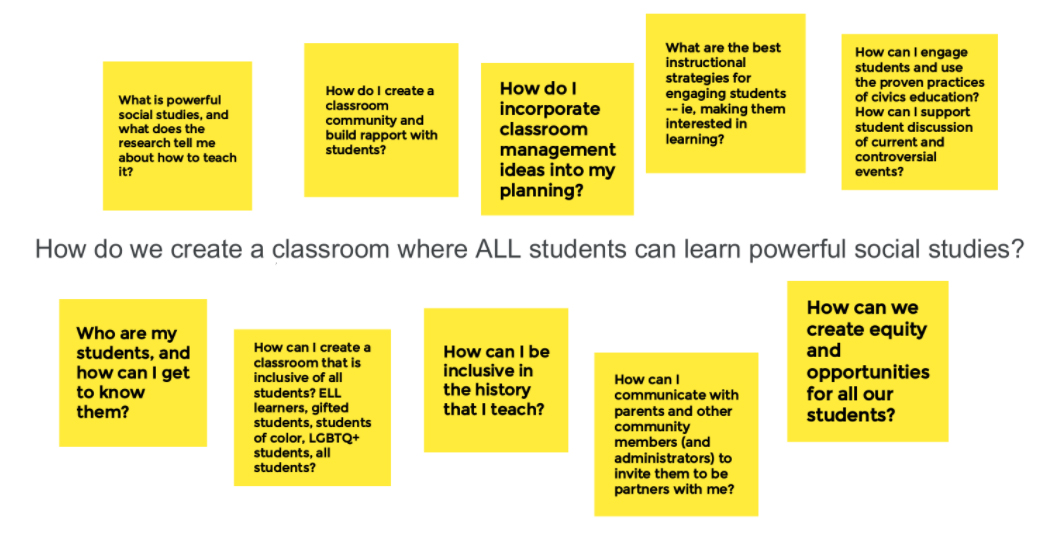Service Learning Prepares Pre-Service Candidates for Powerful Social Studies

The Illinois Civics requirements in both middle and high school have created a need for colleges and universities to iterate their current curriculum to prepare pre-service candidates for the classroom. Dr. Bonnie Laughlin-Schultz, social science teaching coordinator and an associate professor of history at Eastern Illinois University, engaged her students in an inquiry this semester around the essential question, “How can we create powerful social studies for all learners?” This inquiry-based curriculum prepared students to design their own inquiry unit that reflected the proven practices of civic education embedded in the course requirements including current and controversial issue discussions and service learning.
Bonnie, an Illinois Civics Instructional Coach, is one of 26 educators participating in the Guardians of Democracy Microcredential Program with Volunteer Generation Fund support from Serve Illinois to facilitate service learning opportunities for classrooms to work together for the common good of Illinois.
We asked Bonnie to share a bit more about her experience preparing her teacher candidates to teach powerful social studies with service learning.
Can you tell us a bit more about how you engaged your pre-service students to take informed action through service learning endeavors?
The informed action project that we designed reflected upon the essential question that guided the entire methods course, “How can we create powerful social studies for all learners?” My idea had been to create an Essential Question for an inquiry-designed curriculum that could give oversight for our entire social studies teaching methods class, and to encourage students to continue reflecting upon the components of that question in their later education coursework and their careers as teachers. The research and investigation were embedded into the course, as students read works about powerful social studies and inclusive social studies, and they learned research-based strategies for designing instruction for all learners. Additionally, they were able to undertake professional development on teaching current and controversial issues.
The class concludes with students creating their own Inquiry Design Model unit, one in which they intentionally design powerful social studies instruction for all learners. As we approached that, we brainstormed the kinds of questions that supported our essential question, and they brainstormed potential actions to come from them (see below). In this semester — one in which students are under the additional stress of learning during a pandemic — I realized that mylearners needed something simple, but something that could be a springboard for their future, so their action became making a plan for their own further development as an inclusive and powerful social studies educator. In an ideal semester, I would’ve liked to have seen them engage in something more significant — a long-term mandatory reading group, an educational campaign, or some kind of social studies advocacy. Saving that for better times!
How did this activity deepen students’ disciplinary content knowledge and/or meet learning targets for your pre-service teachers?
I have done bigger service learning projects before, and it took me a bit to be OK with the fact that this was not that semester. That said, I built on a strength that I did have — I had taught this class enough times that I could really step back and see how the curriculum led to authentic informed action, and I knew how all the pieces fit together. Sometimes I’ve done what feels like better-informed action, but it perhaps hasn’t been as deeply embedded in the curriculum as this is. My students got to see how an inquiry arc leads to informed action and to think about their own development as social studies educators — what more could I want from a class for future teachers?
How did this project deepen students’ knowledge of themselves and their community?
One of the powerful discussions came as students talked about where they hoped to teach and reflected upon their own identities and those of the school community. We used identity charts from Facing History and Ourselves to think about our own identities and to imagine those of their future students, and this was a good way to lead us to culturally responsive pedagogy and thinking about the many diversities of their future classrooms. Particularly for my students who want to teach in rural Illinois, they often imagine their classrooms as very homogenous, and both the identity charts and a piece we watched where Dr. Diana Hess talked about the diversity inside even the most homogenous-seeming classrooms was very useful to them.
What advice would you give teachers thinking about opportunities for engaging their students in service learning?
- Use the tools and resources that are available to us to make planning and implementing service learning more manageable and planning easier, particularly those that help us work with our students to make service learning authentic and drawn from student interest and experience.
- Start small and be patient with yourself.
- Focus on the payoff when it feels overwhelming — meaningful and authentic student learning that will translate well beyond our classrooms.
How would you answer the essential question, “How can we create powerful social studies for all learners?” Please comment below. Together we can prepare all students with the knowledge, skills, and dispositions for civic life.
